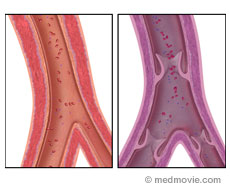![]() Click here to view an animation that discusses Common Vascular Problems
Click here to view an animation that discusses Common Vascular Problems
 The vascular (circulatory) system is made up of blood vessels called arteries and veins. Arteries carry oxygenated blood from the heart to the body. Blood is pushed through the arteries by pressure created by the heart’s beating. Veins carry deoxygenated blood back to the heart. Veins have valves that prevent blood from flowing backwards. Blood flow is slower than in the arteries. The contractions of surrounding muscles help keep the blood moving forward.
The vascular (circulatory) system is made up of blood vessels called arteries and veins. Arteries carry oxygenated blood from the heart to the body. Blood is pushed through the arteries by pressure created by the heart’s beating. Veins carry deoxygenated blood back to the heart. Veins have valves that prevent blood from flowing backwards. Blood flow is slower than in the arteries. The contractions of surrounding muscles help keep the blood moving forward.
You may benefit from this if you have experienced a stroke or mini-stroke, blood clot in blood vessel, pain in your legs when walking, or a history of disease of the circulation in your family, although there are many other possible reasons that might lead your doctor to want to evaluate your circulation health.
Sonography is a useful way of evaluating the body’s circulatory system. Vascular ultrasound is performed to:
- help monitor the blood flow to organs and tissues throughout the body
- locate and identify blockages and abnormalities like blood clots, plaque or emboli and help plan for their effective treatment
- determine whether a patient is a good candidate for a procedure
- to plan or evaluate the success of procedures that graft or bypass blood vessels
Doppler ultrasound images can help the physician to see and evaluate:
- blockages to blood flow (such as clots)
- narrowing of vessels (which may be caused by plaque)
- tumors and congenital malformation
There are some common problems that can occur with the blood vessels. These problems include high blood pressure, atherosclerosis, aneurysm, embolism, varicose veins, and thrombosis.
- High blood pressure, or hypertension, is a condition in which blood pressure levels are measure above the normal ranges. Blood pressure is the force of the blood in your arteries. Your blood pressure is high if it is 140/90 or higher.
- Atherosclerosis is a disease that affects the arteries. It is caused by fatty deposits that begin within the blood vessel wall and eventually progress to cause narrowing of the blood vessel itself. Severe narrowing can stop blood flow.
- An aneurysm is caused by a weakened area in a blood vessel wall. This causes the wall to balloon outward. As the aneurysm becomes larger, the wall becomes weaker and the blood vessel may break open (rupture).
- An embolism is a blood clot that has traveled to another place in the body. These blood clots most commonly form in the veins of the legs. The clots can lodge in smaller arteries, stopping blood flow.
- Varicose veins occur when the valves in a vein do not work properly. As a result, blood pools in the veins and causes the veins to become swollen and twisted. Most commonly, varicose veins occur in the legs.
- A thrombosis is a blood clot that has formed inside a blood vessel. Most commonly they can occur in the veins of the leg (deep vein thrombosis). They can sometimes form in arteries. These blood clots can break off and travel through the blood (embolism).
Last Update 6/24/2008








